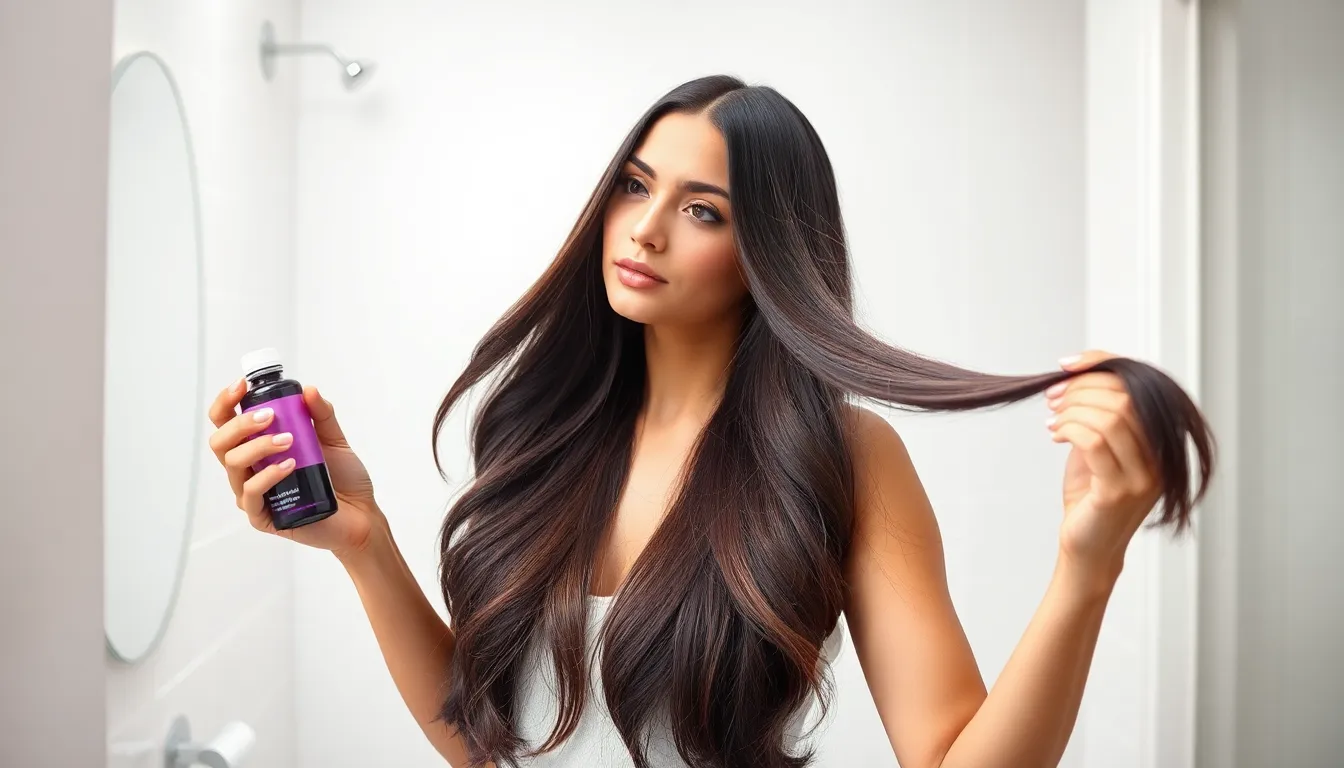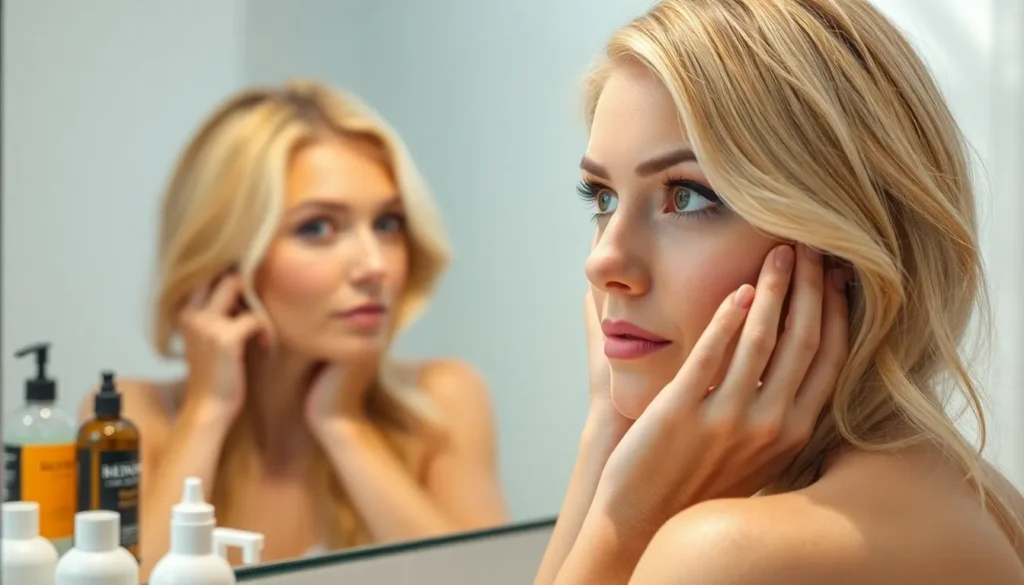We’ve all been there – you just walked out of the salon or finished a DIY hair coloring session, only to realize your hair isn’t quite the shade you envisioned. Maybe there’s an unwanted brassy undertone or your color looks a bit too harsh. That’s where hair toner becomes your secret weapon.
Hair toner is the game-changing product that transforms good hair color into absolutely stunning results. It’s designed to neutralize unwanted tones, enhance your desired shade, and add that professional-looking finish that makes all the difference. Whether you’re dealing with brassiness in blonde hair, want to refresh faded color, or need to perfect a fresh dye job, toner delivers the precise color correction you’re looking for.
Understanding how hair toner works and when to use it can elevate your hair game from amateur to expert level. We’ll guide you through everything you need to know to achieve salon-quality results at home.
What Is Hair Toner and How Does It Work
Hair toner is a specialized cosmetic product that adjusts and refines hair color after bleaching or coloring processes. We’ll explore the scientific principles that make this color correction tool so effective.
Understanding the Science Behind Hair Toner
Hair toner operates through the principle of color theory neutralization, specifically targeting unwanted undertones in bleached or colored hair. We use this science-based approach because complementary colors on the color wheel cancel each other out when applied together.
Purple toners neutralize yellow undertones in blonde hair by depositing violet pigments that counteract brassy hues. Blue based toners eliminate orange undertones that commonly appear in lightened brown hair. Green toners address red undertones that persist after bleaching darker hair colors.
The toner molecules penetrate the hair cuticle and deposit semi permanent pigments into the hair shaft. These molecules are smaller than permanent dye molecules, allowing them to wash out gradually over 4 to 6 weeks. The process works best on hair that’s been lightened to a pale yellow stage, typically at a level 9 or 10 on the hair color scale.
Chemical formulations in modern toners include conditioning agents like keratin proteins and moisturizing compounds. These ingredients help repair damage caused during the bleaching process while depositing corrective pigments. The pH level of most toners ranges between 8.5 and 9.5, which opens the hair cuticle just enough for pigment penetration without causing excessive damage.
The Difference Between Hair Toner and Hair Dye
Hair toner and hair dye serve distinctly different purposes in the coloring process, though many people confuse their functions. We’ve outlined the key differences to help you understand when to use each product.
| Feature | Hair Toner | Hair Dye |
|---|---|---|
| Purpose | Neutralizes unwanted tones | Changes hair color completely |
| Pigment Deposit | Semi permanent, 4-6 weeks | Permanent or semi permanent |
| Application Timing | After bleaching or coloring | Primary coloring process |
| Color Change Level | Subtle adjustments | Dramatic transformations |
| Hair Lightening | Cannot lighten hair | Can lighten with developer |
Hair dye contains larger pigment molecules that penetrate deeper into the hair shaft and create lasting color changes. Permanent hair dyes use ammonia and hydrogen peroxide to lift the natural pigment and deposit new color molecules. This process can lighten hair by several levels while adding the desired shade.
Toners work exclusively on pre lightened hair and cannot change your natural hair color without prior bleaching. We apply toner as a finishing step to perfect the color achieved through dyeing or bleaching. The gentle formula makes toners suitable for frequent use, while permanent dyes require longer intervals between applications to prevent excessive damage.
Processing time differs significantly between these products, with toners typically requiring 10 to 30 minutes compared to 45 minutes or more for permanent dyes. This shorter processing time makes toners ideal for quick touch ups and maintenance between major color treatments.
Essential Types of Hair Toner for Different Hair Goals

Different hair toner formulations target exact color concerns to help you achieve your desired look. We’ll explore the most effective toner types for addressing common hair color challenges.
Purple Toner for Blonde Hair Maintenance
Purple toner eliminates brassy yellow undertones that naturally develop in blonde hair over time. UV exposure, heat styling, and water minerals cause blonde hair to shift toward unwanted warm tones, making purple toner essential for maintaining cool, salon fresh color.
We recommend applying purple toner every 2 to 3 weeks to keep blonde hair looking its best. Professional colorists use purple toner immediately after bleaching to neutralize yellow pigments before they become visible. Blonde hair responds quickly to purple toner, typically requiring only 5 to 15 minutes of processing time depending on the intensity of yellow undertones.
Platinum blonde, ash blonde, and silver blonde shades benefit most from regular purple toner treatments. Light blonde hair shows color changes more dramatically than darker shades, making purple toner particularly effective for these lighter levels.
Blue Toner for Orange Undertone Correction
Blue toner neutralizes orange undertones that appear when dark hair is lightened or when brown hair fades. Orange pigments emerge naturally during the bleaching process, especially in hair that starts at brunette levels 3 through 6. We use blue toner to counteract these warm orange tones through color wheel principles.
Hair that’s been lightened from dark brown to medium blonde often requires blue toner treatment. Orange undertones become most visible in hair that hasn’t been lightened enough or when previous color treatments begin to fade. Blue toner works effectively on hair levels 4 through 7, providing immediate orange neutralization.
Processing time for blue toner ranges from 10 to 25 minutes, depending on the intensity of orange undertones. Darker starting hair colors typically need longer processing times to achieve complete orange neutralization.
Ash Toner for Warm Tone Neutralization
Ash toner combines purple and blue pigments to neutralize multiple warm undertones simultaneously. We use ash toner when hair displays both yellow and orange undertones, creating a comprehensive solution for complex color correction needs.
Natural hair colors often contain multiple warm pigments that become apparent after chemical processing or sun exposure. Ash toner addresses these mixed warm tones more effectively than single color toners. Hair levels 5 through 8 respond best to ash toner treatments, achieving cooler, more neutral results.
Ash toner requires careful timing because it contains multiple corrective pigments. Over processing with ash toner can result in muddy or greenish color, so we recommend starting with shorter processing times of 8 to 12 minutes.
Silver Toner for Gray Hair Enhancement
Silver toner transforms naturally gray or white hair into lustrous, even toned silver. Gray hair often appears dull or yellowed due to environmental factors, medication, or natural aging processes. We use silver toner to restore vibrancy and create uniform color distribution in gray hair.
Natural gray hair contains varying amounts of remaining pigment, creating uneven color appearance. Silver toner deposits light purple and blue pigments to neutralize yellow tones while adding metallic shine. White or light gray hair achieves the most dramatic silver toner results.
Silver toner processing typically takes 15 to 30 minutes, depending on the desired intensity and starting hair condition. Gray hair often has a coarser texture that requires longer processing time for optimal pigment absorption.
Professional vs. At-Home Hair Toner Options

Choosing between professional and at-home toner options depends on your budget, hair condition, and desired results. We’ll explore each approach to help you make the best decision for your hair goals.
Salon-Grade Toner Benefits and Costs
Professional toners deliver superior color correction and longer lasting results. Colorists use high-quality formulations like Wella Color Charm T18 Lightest Ash Blonde and Matrix SoColor that contain higher pigment concentrations than drugstore alternatives. These salon grade products can neutralize stubborn undertones in just 5 to 15 minutes while providing up to 8 weeks of color longevity.
Expert application ensures even coverage and prevents over processing. Stylists assess your hair’s porosity levels and select the appropriate volume developer, typically ranging from 10 to 20 volume depending on your hair’s condition. They also monitor processing times closely to achieve optimal results without causing damage.
Salon toning sessions cost between $75 to $150 depending on your location and hair length. This investment includes professional consultation, high quality products, and guaranteed results. Many salons offer toner touch ups at reduced rates when you return within 4 to 6 weeks.
Drugstore Hair Toner Brands Worth Trying
Clairol Shimmer Lights provides effective purple toning for blonde and silver hair. This budget friendly option costs around $6 and works well for weekly maintenance routines. The formula contains violet pigments that neutralize yellow undertones without over depositing color when used for 3 to 5 minutes.
L’Oréal Colorista Semi Permanent Hair Color offers versatile toning options for multiple hair colors. Available in shades like Silver, Rose Gold, and Peach, these toners cost approximately $8 and last 4 to 10 washes. The conditioning formula helps repair bleach damage while depositing color.
John Frieda Sheer Blonde Go Blonder Lightening Shampoo combines gentle toning with gradual lightening. This dual action product costs around $7 and works over several weeks to both lighten and tone blonde hair simultaneously. Users report visible results after 2 to 3 weeks of regular use.
Wella Color Charm Permanent Liquid Hair Color delivers professional quality results at drugstore prices. Popular shades like T14 Pale Ash Blonde and T27 Medium Beige Blonde cost under $4 and provide reliable color correction when mixed with the appropriate developer volume.
DIY Hair Toner Recipes and Natural Alternatives
Apple cider vinegar creates a gentle clarifying toner that removes product buildup and enhances natural shine. Mix 2 tablespoons of raw apple cider vinegar with 1 cup of cool water for an all natural rinse. This mixture helps seal the hair cuticle and can subtly reduce brassiness when used weekly.
Purple shampoo mixed with white conditioner forms an effective DIY toning treatment. Combine equal parts purple shampoo and deep conditioning mask to create a custom toner that you can leave on for 5 to 10 minutes. This method provides moisture while neutralizing yellow tones.
Green tea rinses offer antioxidant benefits while subtly toning red undertones in brown hair. Brew 3 green tea bags in 2 cups of hot water and let cool completely before applying as a final rinse. The natural tannins help neutralize unwanted red hues while promoting hair health.
Lemon juice and honey masks provide natural lightening and toning effects for lighter hair colors. Mix 2 tablespoons of fresh lemon juice with 1 tablespoon of raw honey and apply to damp hair for 30 to 60 minutes. This combination works gradually over multiple treatments to lighten and brighten blonde hair naturally.
Step-by-Step Guide to Applying Hair Toner Safely

Achieving professional toner results requires careful preparation and precise application techniques. We’ll walk you through each essential step to ensure safe and effective hair toner application.
Preparing Your Hair Before Toner Application
Start by washing your hair with a clarifying shampoo 24 to 48 hours before toning. This removes product buildup and ensures even toner absorption throughout your hair strands. Skip the conditioner during this pre-wash since it creates a barrier that prevents proper toner penetration.
Conduct a strand test on a hidden section of hair before full application. Mix a small amount of toner according to package directions and apply it to a 1-inch section behind your ear. Process for the recommended time to check for allergic reactions and desired color results.
Gather all necessary tools before starting the toning process. You’ll need plastic gloves, a tint brush, non-metallic mixing bowl, plastic clips, old towels, and petroleum jelly to protect your skin. Metal tools can react with toner chemicals and alter the color outcome.
Section your damp hair into 4 equal quadrants using plastic clips. Work with hair that’s about 70% dry since overly wet hair dilutes the toner formula. Apply petroleum jelly around your hairline, ears, and neck to prevent skin staining.
Proper Application Techniques for Even Coverage
Begin toner application at the back sections where hair is typically most damaged and porous. These areas absorb toner more quickly and require the longest processing time for even results. Use a tint brush to apply toner in 1/4-inch sections from mid-length to ends first.
Work the toner through each section using a combing motion with your brush. This technique ensures complete saturation and prevents patchy color results. Apply toner sparingly to previously bleached or highlighted sections since they’ll grab color faster than virgin hair.
Focus on the most brassy areas first before moving to less problematic sections. Yellow undertones typically require more processing time than orange undertones. Check your progress every 5 minutes by gently wiping a small section with a damp cloth.
Avoid overlapping toner application on previously processed areas. This prevents over-processing and potential hair damage. Keep toner away from your scalp to prevent irritation and focus application on the hair shaft where brassiness occurs.
Timing and Processing Guidelines
Process toner for 10 to 20 minutes depending on your starting hair level and desired results. Level 9 and 10 blonde hair typically requires 10 to 15 minutes, while level 7 and 8 hair may need up to 20 minutes for optimal tone neutralization.
Check your hair color every 5 minutes during the processing window. Toner works quickly on damaged or porous hair, so frequent monitoring prevents over-processing. Rinse immediately when you achieve your desired shade since toner continues working until removed.
Time your application strategically to ensure even processing across all sections. Apply toner to each quadrant with 2 to 3 minute intervals between sections. This staggered timing allows you to rinse each area at the optimal moment for uniform color results.
Rinse thoroughly with cool water until the water runs clear. Hot water opens the hair cuticle and allows toner molecules to escape prematurely. Follow with a color-safe conditioner to seal the cuticle and lock in your newly toned color for maximum longevity.
Common Hair Toner Mistakes to Avoid

Even the most carefully planned toner application can go wrong without proper technique. We’ll help you avoid the pitfalls that turn hair dreams into color disasters.
Over-Processing and Color Damage Prevention
Leaving toner on too long ranks as the most destructive mistake we see in DIY hair toning. Processing times vary dramatically between toner types, with purple toners requiring only 3 to 5 minutes while ash toners need 15 to 20 minutes for optimal results. We recommend checking your hair color every 3 minutes during the first application to understand how quickly your hair responds to the toner.
Heat accelerates toner processing speed beyond manufacturer recommendations. Your blow dryer, flat iron, or even hot shower water can cause the toner to work faster than expected. We suggest applying toner to completely cool, damp hair and avoiding heat sources during processing.
Multiple toner applications within 48 hours create cumulative damage that weakens hair structure. Each toning session opens the hair cuticle and deposits pigments, so spacing treatments at least one week apart allows your hair to recover. We’ve found that patience between applications prevents the brittle, straw-like texture that results from over-processing.
Skipping deep conditioning treatments before and after toning compromises hair health. Bleached hair needs moisture restoration to handle toner chemicals effectively. We recommend using a protein-free deep conditioner 24 hours before toning and immediately after rinsing the toner to maintain hair integrity.
Choosing the Wrong Toner Shade
Mismatched toner shades create muddy, uneven results that require professional correction. Purple toners work exclusively on yellow undertones, while blue toners target orange undertones, and using the wrong color wheel opposite intensifies unwanted hues instead of neutralizing them. We suggest photographing your hair in natural daylight to identify the dominant undertone before selecting a toner.
Ignoring your hair’s current level leads to toner selection failures. Level 7 hair requires different toner concentrations than level 10 hair, with darker levels needing stronger formulations to achieve visible results. We recommend consulting the manufacturer’s level chart and choosing toners specifically designed for your starting point.
Using toners on unbleached or virgin hair produces minimal to no color change. Natural hair pigments block toner molecules from penetrating effectively, resulting in wasted product and disappointing outcomes. We advise pre-lightening hair to at least level 8 before applying any toning treatment.
Combining multiple toner shades without understanding color theory creates unpredictable results. Mixing purple and blue toners doesn’t create a stronger neutralizing effect but instead produces muddy gray tones. We recommend using single-shade toners until you master basic application techniques.
Skipping the Strand Test
Performing strand tests prevents costly color disasters and saves entire heads of hair from unwanted results. This 10-minute process reveals exactly how your hair will respond to the chosen toner, including processing time and final color outcome. We always test a hidden section behind the ear or underneath layers where mistakes won’t show.
Different hair sections process toner at varying speeds due to damage levels and porosity differences. Previously bleached areas absorb toner faster than virgin roots, creating uneven color distribution without proper timing adjustments. We suggest testing strands from multiple areas including roots, mid-lengths, and ends to understand processing variations.
Strand testing reveals allergic reactions before they affect your entire scalp. Toner ingredients can cause skin irritation, burning, or severe allergic responses that require immediate medical attention. We recommend leaving the test mixture on skin for 48 hours to identify any adverse reactions.
Documented strand test results serve as reference points for future toning sessions. Recording processing times, toner dilution ratios, and final color outcomes creates a personalized formula for consistent results. We keep detailed notes including photos and timing information to replicate successful toning experiences.
Maintaining Your Hair Toner Results Long-Term

Your toner application success doesn’t end at the salon chair or bathroom mirror. We’ll help you preserve those perfectly balanced tones through strategic product choices and maintenance routines.
Best Shampoos and Conditioners for Toned Hair
Color-safe shampoos extend toner longevity by protecting pigment molecules from premature washing. We recommend sulfate-free formulations that cleanse gently without stripping essential color deposits from your hair cuticle.
Purple shampoos maintain blonde and silver tones by depositing subtle violet pigments during each wash. Use these specialized formulas 2 to 3 times weekly to prevent brassiness from returning between toning sessions.
Blue-based shampoos target orange undertones in brunette and darker blonde hair colors. Apply these products once weekly to maintain cool ash tones and prevent warmth from developing in your color.
Moisturizing conditioners restore hydration levels that bleaching and toning processes often deplete. Look for products containing keratin proteins and natural oils like argan or coconut to repair damaged hair cuticles.
Leave-in treatments provide ongoing protection against environmental factors that cause color fading. These products create a protective barrier around each strand while delivering continuous moisture and UV protection.
How Often to Reapply Hair Toner
Standard reapplication occurs every 4 to 6 weeks for most hair types and toner formulations. We track this timeline based on how quickly your exact hair releases semi-permanent pigments through regular washing.
Frequent washers need toner refreshing every 3 to 4 weeks due to accelerated pigment loss. Daily shampooing removes toner molecules faster than the typical washing schedule of 2 to 3 times weekly.
Damaged hair requires more frequent toning sessions every 2 to 3 weeks because compromised cuticles release pigments more quickly. Bleached and chemically processed hair falls into this category and needs consistent maintenance.
Root touch-ups become necessary every 6 to 8 weeks as natural hair growth introduces untoned segments. Focus toner application on new growth areas while avoiding over-processing previously toned lengths.
Seasonal adjustments influence toning frequency based on sun exposure and swimming activities. Summer months typically require more frequent applications due to chlorine exposure and UV damage that strips toner pigments.
Protecting Toned Hair from Fading
UV protection prevents sun damage that breaks down toner molecules and causes color shifts. We apply hair products containing SPF 15 or higher before outdoor activities and extended sun exposure.
Heat styling limits preserve toner integrity by avoiding excessive thermal damage. Keep styling tools below 350°F and always apply heat protectant products before using blow dryers, flat irons, or curling tools.
Cool water rinses seal hair cuticles and lock in toner pigments during your washing routine. Hot water opens cuticles and allows color molecules to escape more rapidly than lukewarm or cool temperatures.
Swimming precautions include pre-wetting hair with clean water and applying leave-in conditioner before entering pools. Chlorinated water strips toner faster than regular tap water and can cause unwanted color shifts.
Dry shampoo alternatives reduce washing frequency without compromising hair cleanliness. These products absorb excess oils and extend time between washes, helping preserve toner pigments for longer periods.
Silk pillowcases minimize friction damage that can cause color fading and hair breakage. Cotton pillowcases create more friction against hair strands, potentially lifting cuticles and releasing toner pigments during sleep.
When to Seek Professional Help with Hair Toner

While DIY toner application works for many situations, certain circumstances require professional expertise to achieve safe and effective results. Complex color challenges often exceed the capabilities of at-home products.
Complex Color Corrections
Multiple undertone issues demand professional assessment and custom toner formulations that drugstore products can’t address. We’ve seen cases where hair contains both yellow and orange undertones alongside green discoloration from chlorine exposure, requiring a multi-step correction process with different toner strengths.
Previous color buildup from multiple DIY attempts creates unpredictable reactions when new toners are applied. Professional colorists use color removers and specialized products to strip unwanted pigments before applying corrective toners.
Uneven color distribution across different sections of hair requires strategic toner application with varying processing times. Stylists can identify which areas need stronger formulations and adjust application techniques accordingly.
Color theory complications arise when hair has been lightened unevenly or processed with incompatible products. Professional colorists understand how different chemical processes interact and can prevent further damage while achieving desired results.
Severely Damaged Hair Considerations
Compromised hair cuticles from over-bleaching can’t properly hold toner pigments, leading to patchy results and further breakage. We recommend protein treatments and professional assessment before any toner application on severely damaged hair.
Chemical burns or scalp irritation from previous treatments require immediate professional attention. Licensed stylists can evaluate hair and scalp health to determine if toner application is safe or if healing time is needed.
Extensive breakage throughout the hair shaft indicates that additional chemical processing could cause irreversible damage. Professional treatments focus on hair reconstruction before color correction.
Elasticity loss becomes evident when hair stretches excessively when wet or breaks easily when dry. Salon-grade bond builders and conditioning treatments must precede any toner application.
Achieving Dramatic Color Transformations
Going from dark to platinum requires multiple lightening sessions followed by precise toner application that only professionals can safely execute. We’ve observed that attempting this transformation at home often results in severe damage or chemical burns.
Creating fashion colors like silver, rose gold, or pastels demands hair lightened to level 9 or 10, which requires professional expertise to achieve without destroying hair integrity. These transformations typically require custom toner blends and exact application techniques.
Correcting previous salon mistakes involves understanding what products were used and how to safely reverse unwanted results. Professional colorists have access to specialized color removers and correction techniques not available to consumers.
Maintaining vibrant results for dramatic color changes requires professional-grade toners with higher pigment concentrations and longer-lasting formulations. Salon toners can maintain these bold colors for 8 to 12 weeks compared to 4 to 6 weeks for at-home products.
Conclusion
We’ve covered everything you need to know about transforming your hair color with toner. From understanding color theory basics to mastering application techniques we’ve given you the tools to achieve salon-quality results at home.
Remember that successful toning starts with choosing the right shade for your hair level and undertones. Whether you’re using purple toner for blonde maintenance or blue toner for orange correction the key lies in proper timing and technique.
Don’t forget that maintaining your toned hair requires ongoing care with color-safe products and regular touch-ups every 4 to 6 weeks. With these strategies you’ll keep your hair looking vibrant and professionally styled between salon visits.
Most importantly know when to seek professional help for complex color challenges. While DIY toning works wonderfully for routine maintenance some situations require expert knowledge to achieve your desired results safely.
Frequently Asked Questions
What is hair toner and how does it work?
Hair toner is a semi-permanent coloring product that neutralizes unwanted undertones in bleached or colored hair. It works using color theory principles, where complementary colors cancel each other out. The toner molecules penetrate the hair cuticle and deposit pigments that gradually fade over 4-6 weeks. Most toners also contain conditioning agents to help repair damage from bleaching processes.
What’s the difference between hair toner and hair dye?
Hair toner is used for subtle color adjustments after bleaching and cannot lighten hair on its own. It’s applied as a finishing step with shorter processing times. Hair dye, however, is designed for dramatic color changes, can lighten natural hair color, and provides permanent results. Toners are ideal for quick touch-ups, while dyes require longer intervals between applications.
Which type of hair toner should I use for my hair color?
Purple toner eliminates yellow undertones in blonde hair and should be used every 2-3 weeks. Blue toner corrects orange undertones in darkened hair. Ash toner neutralizes both yellow and orange undertones simultaneously. Silver toner enhances gray hair by restoring vibrancy and uniformity. Choose based on your specific undertone issues and desired results.
Can I use hair toner at home or should I go to a salon?
Both options work depending on your needs and budget. At-home toners are budget-friendly and effective for basic color correction, with many drugstore brands available. Professional salon toners offer superior color correction, longer-lasting results, and expert application. Complex color challenges, severe damage, or dramatic transformations are best handled by professionals.
How often should I apply hair toner?
Standard reapplication is recommended every 4-6 weeks. However, this varies based on hair type and washing frequency. If you wash your hair frequently or have damaged hair, you may need to reapply more often. Monitor your hair’s undertones and reapply when brassy or unwanted tones begin to reappear.
What are some natural alternatives to commercial hair toners?
Apple cider vinegar rinses help balance hair pH and reduce brassiness. Purple shampoo and conditioner mixtures provide gentle toning. Green tea rinses add subtle ash tones to neutralize warmth. Lemon juice and honey masks can lighten and tone hair naturally. These alternatives are gentler but may require more frequent applications for noticeable results.
How do I apply hair toner safely at home?
Start by washing hair with clarifying shampoo and conducting a strand test. Section your hair and apply toner to brassy areas first, working systematically for even coverage. Monitor color every 5 minutes to prevent over-processing. Rinse with cool water when desired tone is achieved. Always follow product instructions and avoid applying heat during processing.
What mistakes should I avoid when using hair toner?
Avoid over-processing by monitoring timing closely and never exceeding recommended processing times. Don’t skip strand tests, as they prevent adverse reactions and ensure even results. Choose the correct toner shade for your hair level and undertones. Avoid applying heat during processing, and never apply toner to unwashed or product-laden hair for best results.
How can I make my hair toner results last longer?
Use color-safe, sulfate-free shampoos and conditioners to preserve toner pigments. Incorporate purple or blue shampoos into your routine for maintenance between toning sessions. Protect hair from UV rays, limit heat styling, and wash with cool water. Use dry shampoo alternatives and sleep on silk pillowcases to minimize friction damage and color fading.
When should I seek professional help with hair toner?
Consult a professional for complex issues like multiple undertone problems, previous color buildup, or severe hair damage. Dramatic color transformations (dark to platinum, fashion colors) require professional expertise for safety and effectiveness. If you’re experiencing uneven color distribution or have never used toner before, professional guidance ensures optimal results and prevents potential damage.







